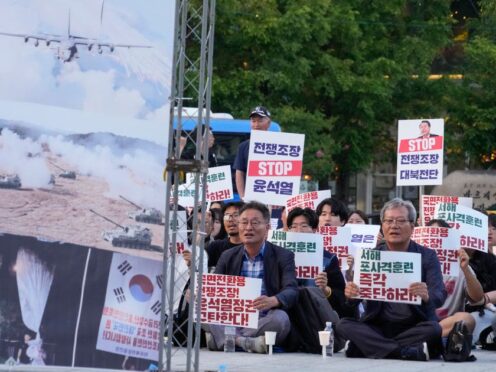South Korea’s military says North Korea has launched more balloons likely carrying refuse towards South Korea.
A joint chiefs of staff statement said the balloons are moving south.
It asks South Korean citizens not to touch North Korean balloons and report them to military and police authorities.
The launches came days after North Korean leader Kim Jong Un and Russian President Vladimir Putin signed a major defence deal that observers worry could embolden Mr Kim to direct more provocations at South Korea.
Starting in late May, North Korea launched a series of balloons that dropped manure, cigarette butts, scraps of cloth, waste batteries and vinyl in various parts of South Korea.
No highly dangerous materials were found. North Korea said its balloon campaign was a tit-for-tat action against South Korean activists who flew political leaflets critical of its leadership across the border.
Mr Kim’s influential sister, Kim Yo Jong, suggested on Friday that North Korea would resume its balloon campaign in retaliation for South Korean civilian groups’ new round of leaflet activities.

A South Korean group said it sent 20 balloons carrying 300,000 propaganda leaflets, 5,000 USB sticks with South Korean pop songs and TV dramas and US one-dollar bills across the border on Thursday night.
“When you do something you were clearly warned not to do, it’s only natural that you will find yourself dealing with something you didn’t have to,” Kim Yo Jong said.
In reaction to North Korea’s earlier balloon campaign, South Korea’s military on June 9 redeployed gigantic loudspeakers along the border for the first time in six years and resumed anti-North Korean propaganda broadcasts.
The broadcasts reportedly included hits by K-pop sensation BTS such as Butter and Dynamite, weather forecasts and news on Samsung, the biggest South Korean company, as well as criticism of North Korea’s missile program and its crackdown on foreign videos.
North Korea views front-line South Korean broadcasts and civilian leafleting campaigns as a grave provocation because it bans access to foreign news for most of its 26 million people.
The North has reacted to past South Korean loudspeaker broadcasts and civilian balloon activities by firing rounds across the border, prompting South Korea to return fire, according to South Korea.
Earlier on Monday, South Korea, the United States and Japan issued a joint statement strongly condemning expanding military cooperation between Russia and North Korea. It said the North Korean-Russian moves should be of “grave concern” to efforts to promote peace on the Korean Peninsula, the global non-proliferation regime and support for the Ukraine people.
During a meeting in Pyongyang, North Korea’s capital last Wednesday, Kim Jong Un and Mr Putin struck a deal requiring each country to provide aid if attacked and vowed to boost other cooperation.
Observers say the accord represents the strongest connection between the two countries since the end of the Cold War.
The US and its partners believe North Korea has been providing Russia with much-needed conventional arms for its war in Ukraine in return for military and economic assistance.
